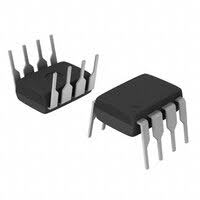The LM358 op-amp is a staple in analog electronics — valued for its simplicity, low cost, and wide availability. It’s used in everything from sensor circuits to audio preamps. However, if you’ve ever searched for this part at an electronic components distributor, you’ve likely come across two very similar part numbers: LM358P and LM358N.
This often leads to confusion: Are they the same? Is one better than the other? And more importantly, does the difference really matter in your design or procurement?
In this article, we’ll explore LM358P vs LM358N, comparing datasheet specifications, packaging differences, and whether these suffixes affect real-world performance — especially when sourcing parts from your preferred electronic components distributor.
What Is the LM358?
The LM358 is a dual operational amplifier consisting of two independent op-amps in a single 8-pin package. It is optimized for single-supply operation and is commonly used in low-power analog signal processing applications such as:
- Sensor signal conditioning
- Active filters
- Audio pre-amplifiers
- Comparators
- Low-speed integrators
This op-amp has been around for decades and is manufactured by several companies including Texas Instruments, ON Semiconductor, STMicroelectronics, and NXP, which often leads to different suffixes being used to designate part variants.
What Do “P” and “N” Mean in LM358?
Suffixes like P and N are generally used to indicate the package type, temperature range, or manufacturer-specific codes. The challenge? Not all manufacturers use the same suffix conventions.
| Suffix | Typical Meaning | Common Manufacturer |
| P | Plastic DIP (PDIP) | Texas Instruments |
| N | DIP (Dual In-Line Package) | ON Semiconductor, NXP |
| A | Improved grade (optional) | Varies |
| DR | SOIC / Tape and Reel (SMD) | TI, ST, ON, etc. |
In the case of LM358P vs LM358N, both typically refer to through-hole DIP-8 packages, and both are functionally identical. The difference lies more in labeling and source than in performance.
Datasheet Comparison: LM358P vs LM358N
To make a fair comparison, let’s take two popular versions from major manufacturers — Texas Instruments LM358P and ON Semiconductor LM358N — and see how their specs match up:
As you can see, there is no meaningful electrical difference between these two parts. The only differences lie in manufacturer labeling and sourcing information.
| Parameter | LM358P (TI) | LM358N (ON Semiconductor) |
| Package Type | PDIP-8 | DIP-8 |
| Input Offset Voltage | ±2 mV (typ), ±7 mV (max) | ±2 mV (typ), ±7 mV (max) |
| Supply Voltage Range | 3V to 32V (or ±1.5V to ±16V) | 3V to 32V |
| Input Bias Current | ~45 nA (typ) | ~45 nA (typ) |
| Slew Rate | ~0.3 V/μs | ~0.3 V/μs |
| Gain Bandwidth Product | 1 MHz | 1 MHz |
| Operating Temp. Range | -40°C to +85°C | -40°C to +85°C |
| RoHS Compliant | Yes | Yes |
Both the LM358P and LM358N share identical core specifications — from input offset voltage to bandwidth and operating temperature. Any minor differences, such as slight naming convention variations (PDIP vs. DIP), have no impact on circuit performance.
The datasheet comparison confirms what most engineers already suspect:
Functionally, these two parts are equivalent in every meaningful way.
That said, brand-specific quality control, packaging format, and regional availability may differ slightly between manufacturers like Texas Instruments and ON Semiconductor, which can influence procurement decisions — especially in mass production or regulated environments.
In short, when it comes to LM358P vs LM358N, you’re choosing between logos, not between electrical capabilities.
When Does the LM358P vs LM358N Difference Actually Matter?
In 95% of cases, it doesn’t. However, there are a few edge cases where paying attention to suffixes can help avoid sourcing or compatibility issues:
Automated Assembly & PCB Design
If you’re using automated pick-and-place machines, suffixes like “P” and “N” can determine tape-and-reel packaging, lead type, or reel orientation. For example, LM358DR would be a surface-mount SOIC version, not suitable for through-hole boards.
Although both LM358P and LM358N are DIP packages, some production lines are configured for very specific part codes. Confirming exact suffixes with your contract manufacturer may avoid compatibility headaches.
BOM Locking for Long-Term Manufacturing
In high-volume or regulated industries, parts are locked in with exact manufacturer part numbers to ensure sourcing consistency. If your BOM lists LM358P, you may not be allowed to substitute LM358N without formal testing or qualification.
Discrepancies in Distribution Channels
Sometimes distributors list LM358P and LM358N as separate products even though they are functionally the same. One may be in stock and the other out of stock. Knowing that you can safely substitute between them gives you more sourcing flexibility.
Certification Requirements
In aerospace, automotive, or medical applications, even minor packaging changes can require retesting. While the LM358 family isn’t typically used in critical safety systems, it’s something to keep in mind for larger projects.
Can You Substitute LM358P and LM358N?
Absolutely.
If your PCB layout supports a DIP-8 package and you’re dealing with general analog signal processing, you can swap LM358P with LM358N freely. They share the same pinout, supply voltage, input/output behavior, and thermal ratings.
What you shouldn’t do is confuse them with other suffixes like:
- LM358DR / DT – Surface-mount versions
- LM358A – In some cases, a higher grade (lower offset, higher cost)
- LM358PW – TSSOP package (tiny SMD)
Always check the full part number and refer to the datasheet from the specific manufacturer to ensure compatibility.
Conclusion
In the end, the LM358P vs LM358N comparison boils down to packaging code and manufacturer — not performance. As long as you’re using the same package and pinout, both parts are:
Electrically identical
Fully interchangeable
Widely supported by manufacturers and distributors
Unless you’re in a highly regulated design or production environment, there is no functional difference between the two.
So the next time you’re building an analog circuit and you can’t find the exact part number, don’t worry — LM358P and LM358N are two sides of the same analog coin.











